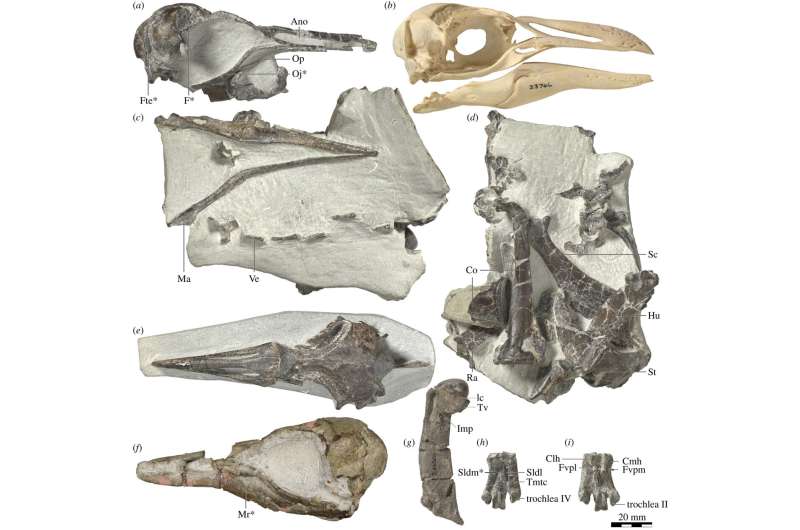Eudyptes atatu sp. nov. showing key diagnostic features. Holotype specimen NMNZ S.046318 showing (a) right lateral view of skull and block with (c) mandible and (d) postcranial elements. (b) Right lateral view of Snares crested penguin Eudyptes robustus NMNZ OR.023746 for comparison. Referred material of E. atatu including (e) S.046315 dorsal view of skull, (f) CM 2017-62-8-1 left lateral view of skull, (g) NMNZ S.046320 right humerus caudal view, and (h) dorsal and (i) plantar views of NMNZ S.046319 right tarsometatarsus. Ano, apertura nasale ossea (naris). Clh, crista lateralis hypotarsi (lateral hypotarsal crest); Co, coracoid; Cmh, crista medialis hypotarsi (medial hypotarsal crest); F*, frontal with wide shelf bordering the salt gland fossa; Fte*, fossa temporalis (temporal fossa) that is relatively deep; Fvpl, foramen vasculare proximale lateralis (medial proximal vascular foramen); Fvpm, foramen vasculare proximale mediale (medial proximal vascular foramen); Hu, humerus; Ic, incisura capitus (capital incisure); Imp, impressio musculus pectoralis (pectoral muscle impression); Mr, ramus mandibula (mandibular ramus); Oj*, os jugale (jugal bar) showing distinct curvature; Op, os palatinum (palatine); Ma, articular end of mandible; Mr*, mandibular ramus that is relatively narrow at midpoint; Ra, radius; Sc, scapula; Sldl, sulcus longitudinalis dorsalis lateralis (lateral dorsal longitudinal sulcus); Sldm*, sulcus longitudinalis dorsalis medialis (medial dorsal longitudinal sulcus) which is moderately deep; St, sternum; Tmtc, tuberositas musculus tibialis cranialis (tuberosity for cranial tibial muscle); Tv, tuberculum ventral (ventral tubercle); Ve, vertebra. Asterisks denote diagnostic characters. Photographs (a)–(e), (g)–(i) from Jean-Claude Stahl at Museum of New Zealand Te Papa Tongarewa, photograph (f) from R. Paul Scofield at Canterbury Museum. Credit: Proceedings of the Royal Society B (2020). 10.1098/rspb.2020.1497
A team of researchers from New Zealand and the U.S. is reporting on the discovery of unearthed 3.36-million-year-old crested penguin fossils found on New Zealand's North Island. In their paper published in Proceedings of the Royal Society B, the group describes the find and why they believe it could provide a link with modern penguins.
A group of local collectors discovered the fossilized remains of the penguin embedded in rock along a coastal tract near Taranaki on New Zealand's North Island. They alerted workers at the Museum of New Zealand Te Papa Tongarewa. The researchers with this new effort retrieved the fossils from the rocks and studied them, hoping to find a link between modern Eudyptes and those of ancient times. Eudyptes are a genus of crested penguins. In modern times, there are between four and seven varieties of them.
The fossilized remains included feathers, leg, rib and wing bones, along with a skull and associated jaw and beak—enough to identify it as a member of Eudyptes. They named it Eudyptes atatu ("dawn" in the Maori language). Crested penguins have crests, which are hair-like tufts that grow out of the sides of their heads. Modern crested penguins are black and white with red eyes, bills and crests, and live on sub-Antarctic islands in the southern oceans. The researchers believe E. atatu likely had similar features, with a red bill and yellow feathers. They note that the ancient penguin's bill was not as wide as modern crested penguins, which suggested it likely had a different food source than modern penguins.
The researchers note that New Zealand is what many describe as a global hotspot for seabird diversity. The richness of food sources surrounding the island attracts seabirds from around the world. They are hoping E. atatu will provide a link of sorts to trace the rise of New Zealand as such a draw to so many birds. To date, few fossils have been found to provide clues. The researchers also expect that further study of the find will help in developing an ancestral tree for crested penguins, and perhaps other seabirds, as well.
More information: Ancient crested penguin constrains timing of recruitment into seabird hotspot, Proceedings of the Royal Society B (2020). royalsocietypublishing.org/doi … .1098/rspb.2020.1497
Journal information: Proceedings of the Royal Society B
© 2020 Science X Network
























